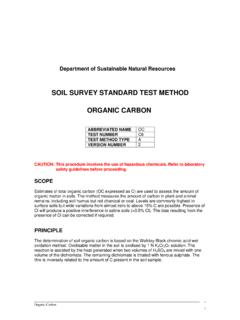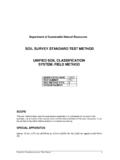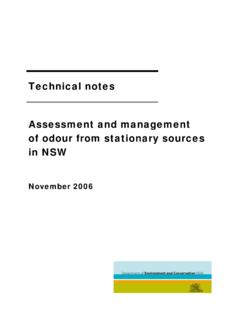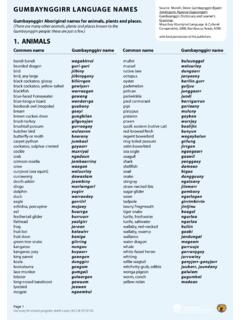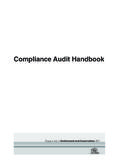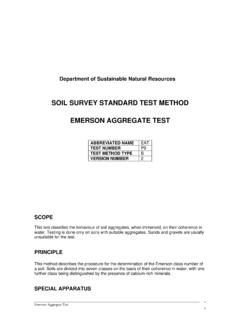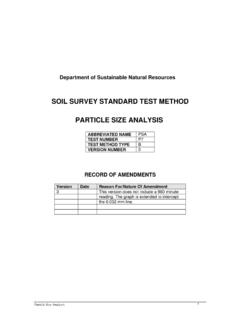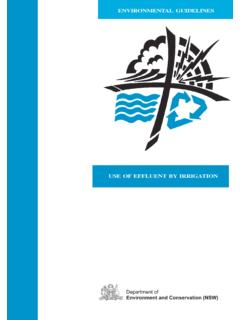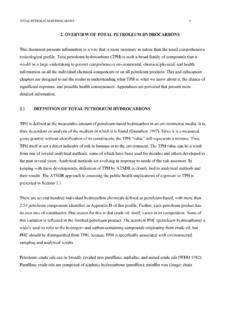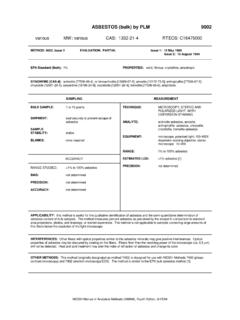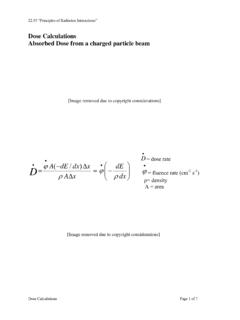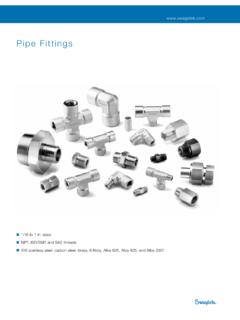Transcription of Unified Soil Classification System
1 Unified Soil Classification System : Field Method1 Department of Sustainable Natural ResourcesSOIL SURVEY STANDARD TEST METHODUNIFIED SOIL Classification System : FIELD METHOD ABBREVIATED NAMEUSCSTEST NUMBERP13 TEST METHOD TYPEBVERSION NUMBER2 SCOPEThis test method describes the engineering properties of a soil based on the size of theparticles, the amounts of the various sizes and the characteristics of the very fine grains. It canbe carried out by either field examination or laboratory APPARATUSS ieves, 75 mm, mm (ASTM No 4), mm (ASTM No 10), mm aperture (ASTM No40). Unified Soil Classification System : Field Method2 PROCEDUREF ield Classification Technique for Coarse-Grained Soils1. Take a representative sample of soil (excluding particles >75 mm) (see Note 1) andclassify the soil as coarse-grained or fine-grained by estimating whether 50% by weight, ofthe particles can be seen individually by the naked eye.
2 Soils containing >50% of particlesthat can be seen are coarse-grained soils; soils containing <50% of particles smaller thanthe eye can see are fine-grained soils. If the soil is predominantly coarse-grained, identifyas being a gravel or a sand by estimating whether 50% or more, by weight, of the coarsegrains are larger or smaller than mm (No 4 sieve size).2. If the soil is a gravel, identify as being "clean" (containing little or no fines, <5%) or "dirty"(containing an appreciable amount of fines, >12%). For clean gravels final Classification ismade by estimating the gradation: the well-graded gravels belong to the GW groups anduniform and gap-graded gravels belong to the GP group. Dirty gravels are of two types:those with non-plastic (silty) fines (GM) and those with plastic (clayey) fines (GC). Thedetermination of whether the fines are silty or clayey is made by the three manual tests forfine-graded If a soil is a sand, the same steps and criteria are used as for gravels in order to determinewhether the soil is a well-graded clean sand (SW), poorly-graded clean sand (SP), sandwith silty fines (SM) or sand with clayey fines (SC).
3 4. If a material is predominantly (>50% by weight) fine-grained, it is classified into one of sixgroups (ML, CL, OL, MH, CH, OH) by estimating its dilatancy (reaction to shaking), drystrength (crushing characteristics), and toughness (consistency near the plastic limit) andby identifying it as being organic or inorganic. (See Note 2.) Unified Soil Classification System : Field Method3 Table 1. Summary of Field Identification TestsCOARSE-GRAINEDSOILSMore than half thematerial (by weight) isindividual grainsvisible to thenaked eyeGRAVELLY SOILSMore than half ofcoarse fraction is larger mmCLEAN GRAVELSWill not leave a stain on awet palmSubstantial amounts of all grain particle sizesGWPredominantly one size or range of sizes withsome intermediate sizes missingGPDIRTY GRAVELSWill leave a stain on a wetpalmNon-plastic fines (to identify, see ML below)GMPlastic fines (to identify, see CL below)GCSANDY SOILSMore than half ofcoarse fractionis smaller mmCLEAN SANDSWill not leave a stain on awet palmWide range in grain size and substantialamounts of all grain particle one size or a range of sizes withsome intermediate sizes missingSPDIRTY SANDSWill leave a stain on a wetpalmNon-plastic fines (to identify, see ML below)
4 SMPlastic fines (to identify, see CL below)SCRibbon LiquidLimitDryCrushingStrengthDilatancyR eactionToughnessStickinessNone <50 None toSight Rapid Low None ML Weak<50 Medium toHighNone toVery SlowMedium toHighMediumCLStrong>50 Slight toMediumSlow toNoneMediumLowMHFINE-GRAINEDSOILSMore than halfthe material (byweight) isindividual grainsnot visible to thenaked eye(< mm)VeryStrong>50 High toVery HighNoneHighVery HighCHHIGHLYORGANICSOILSR eadily identified by colour, odour, spongy feel and frequently by fibrous textureOLOHPtUnified Soil Classification System : Field Method4 Dilatancy (Reaction to Shaking)After moving particles > mm (No 40 sieve size), prepare a pat of moist soil with a volume ofabout 10 cm3. Add enough water, if necessary, to make the soil soft but not the pat in the open palm of one hand and shake horizontally, striking vigorously againstthe other hand several times.
5 A positive reaction consists of the appearance of water on thesurface of the pat which changes to a livery consistency and becomes glossy. When thesample is squeezed between the fingers, the water and the gloss disappear from the surface,and the pat stiffens and finally it cracks or crumbles. The rapidity of appearance of waterduring shaking and of its disappearance during squeezing assist in identifying the character ofthe fines in a fine clean sands give the quickest and most distinct reaction whereas a plastic clay hasno reaction. Inorganic silts, such as a typical rock flour, show a moderately quick Strength (Crushing characteristics)After removing particles > mm (No 40 sieve size) mould a pat of soil to the consistency ofputty, adding water if necessary. Allow the pat to dry completely by oven, sun or air drying,and then test its strength by breaking and crumbling between the fingers.
6 This strength is ameasure of the character and quantity of the colloidal fraction contained in the soil. The drystrength increases with increasing dry strength is characteristic for clays of the CH group. A typical inorganic silt possessesonly very slight dry strength. Silty fine sands and silts have about the same slight dry strength,but can be distinguished by the feel when powdering the dried specimen. Fine sand feelsgritty whereas a typical silt has the smooth feel of (Consistency near plastic limit)After removing particles larger than the mm (No 40 sieve size), a specimen of soil about 10cm3 in size is moulded to the consistency of putty. If too dry, water must be added and ifsticky, the specimen should be spread out in a thin layer and allowed to lose some moisture byevaporation. Then the specimen is rolled out by hand on a smooth surface or between thepalms into a thread about 3 mm in diameter.
7 The thread is then folded and re-rolledrepeatedly. During this manipulation, the moisture content is gradually reduced and thespecimen stiffens, finally loses its plasticity and crumbles when the plastic limit is the thread crumbles, the pieces should be lumped together and a slight kneading actioncontinued until the lump tougher the thread near the plastic limit and the stiffer the lump when it finally crumbles,the more potent is the colloidal clay fraction in the soil. Weakness of the thread at the plasticlimit and quick loss of coherence of the lump below the plastic limit indicate either inorganicclay of low plasticity, or materials such as kaolin-type clays and organic organic clays have a very weak and spongy feel at the plastic Soil Classification System : Field Method5 REFERENCESC harman, PEV & Murphy, BW (eds) 1991, Soils: Their Properties and Management: A SoilConservation Handbook for New South Wales.
8 Sydney University Bureau of Reclamation 1960, Design of Small Dams. US Government Printing Office. NOTES1. This value is not included in the USCS. It is necessary to know the amount of particles >75mm if gravel content is Many natural soils will have property characteristics of two groups because they are closeto the borderline between the groups, either in percentages of the various sizes or inplasticity characteristics. For this substantial number of soils, boundary classifications areused the groups symbols most nearly describing the soil are connected by a hyphen,such as boundary Classification of a soil near the borderline between coarse-grained andfine-grained soils is accomplished by classifying it first as a coarse-grained soil and then asa fine-grained soil. Such Classification as SM-ML and SC-CL are common.
